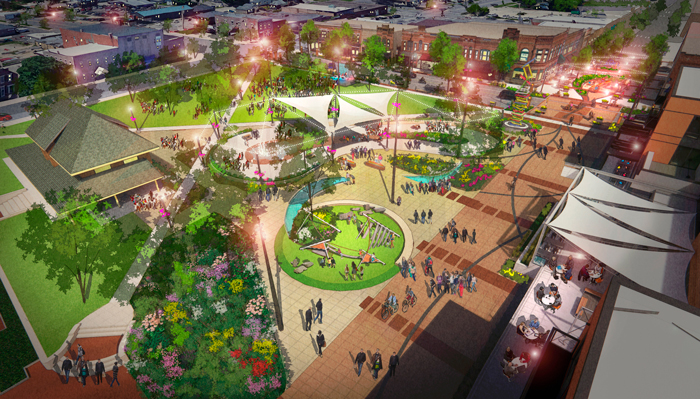French writer and aviator Antoine de Saint-Exupery once wrote that “A goal without a plan is just a wish.” And it seems this practical statement is a sentiment oftentimes shared by those who oversee parks or park systems, open space areas or recreation facilities, which are all entities that commonly construct master plans to help guide their visions. These plans consider location, natural resources, current amenities and community desires. They help identify recreation needs, predict future demand and develop policies for physical and social planning.
Eric Hornig, senior principal with Hitchcock Design Group, listed some ways that these plans contribute to better community offerings, including providing a truer understanding of a district’s assets and offerings; examining how a district stacks up against other similar recreation providers; providing a state of readiness for grants, private funding and opportunities; hearing community voices and building consensus; and building consensus with staff and elected leadership. These plans can provide “a roadmap for achievable results to guide staff and leadership on daily operations and capital projects,” said Hornig.
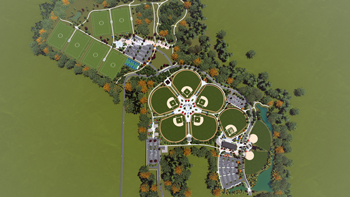
“If you’re doing a five-, 10- or 20-year master plan of a park, the goal is to understand and address what the community is looking for and what it might be lacking today, and then build flexibility and understanding into the plan about how the vision and needs might change in the future,” said Colt McDermott, market leader for city parks at RDG Planning & Design. “It’s also important to understand phasing—what might be possible today and also in the future and associate that with projected costs.”
McDermott said they work on both singular park plans and comprehensive park system master plans. “A similarity between the two is that we’ll study the community and park system and programming elements related to the overall wellness of the community in addition to reviewing the current programming.”
He explained that large-scale comprehensive planning aims to achieve success across the park system. When looking at individual parks, they’ll consider how the space supports community goals at large, having design teams do walking radiuses to understand what areas within a community might be lacking in overall park space. “For a singular park master plan, we start broadly to first understand what’s going on with the system, and then dive into the specifics to understand what people are looking for in that particular park and what trends we should incorporate.” These trends might include natural play systems, sport courts, event space or open green space.
While some municipalities and parks departments construct their master plans in-house, it’s quite common for these entities to seek consultation from outside planning and design firms. McDermott said they’re often brought in to be a “professional practitioner,” since they consult on many project types across multiple scales in communities throughout the country. “We bring a different perspective and new ideas to a community and can often serve as an objective sounding board for community engagement. We’re multidisciplinary, so we have people who can come in and look at everything from lighting to artistic efforts to landscape architecture and bring a holistic understanding to what clients are asking for.”
According to Hornig, unless a district has a large, savvy internal planning department, a consultant team is preferred. He pointed out that outside consultants have a fresh perspective drawn from years of working with similar agencies and they typically have more sophisticated mapping and evaluation tools and current software. “Outside consultants bring an unbiased, ground-up approach covering all the bases with no internal baggage or politics.”
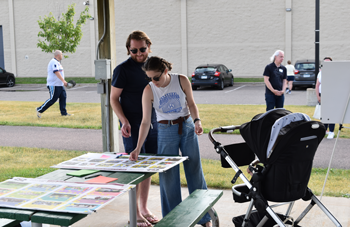
And if discussing major projects, districts can seek out teams with expertise in specialty areas like golf, aquatics, sports, programming or operations. “Outside consultants might be able to draw out ideas anonymously that wouldn’t be expressed with leadership in the room”, Hornig added.
In Franklin County, Ky., the Lakeview Park Committee looked to put together a master plan in 2021 to serve Lakeview Park, located in Frankfort. The plan would assess existing properties, facilities, services and operations, and determine community sentiment about them. It would assist in recognizing recreational prioritizations as identified by the community and define strategic and measurable goals for the next five to 10 years. The planning effort followed a three-phase process including the Analyze Phase, the Connect Phase, featuring extensive public outreach, and finally the Envision Phase, where the consultant team documented final recommendations.
Hitchcock Design was the lead for the Lakeview Park project, and Senior Principal Randy Royer described how the public input process revealed a desire to improve existing facilities, including a golf course and driving range, baseball/softball fields, shelters, a walking path, a tractor pull area for the county fair and pedestrian connections to adjacent neighborhoods. The community and stakeholders also sought to add a sports/conference center, outdoor amphitheater, accessible playground, dog park and restrooms.
“They intend to add services and programs through the multi-use sports/conference center,” said Royer, as well as hold indoor and outdoor sports tournaments. “Sports tourism seems to be a very sought-after item, as well as creating park spaces that serve multiple functions and provide both active and passive recreation opportunities.”
Hopkins, Minn., a suburb of Minneapolis, began work in 2022 to put together its own master plan. “(We’ve) never had a master plan for our park system, so this is starting from scratch for us, which is really exciting,” said PeggySue Imihy Bean, management analyst and racial equity coordinator with the city of Hopkins. “Our Park System Master Plan is going to be a 20-year look at our built infrastructure, our funding systems and best practices for maintenance.”
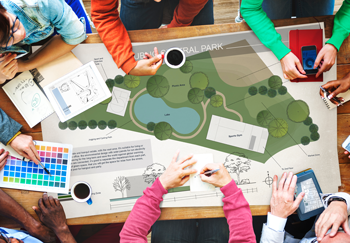
Hopkins worked with landscape architecture firm Confluence, along with several subcontractors with specialties in financial analysis and community engagement.
An engagement website was set up, which utilized a software program to get community engagement through a variety of web-based tools. Imihy Bean described how a map allowed residents to leave comments and ideas pinned on specific locations. There was also a survey, a comment forum where residents could discuss specific parks topics and a ranking activity to help identify priorities and goals. She said they were very happy with the amount of traffic and the responses. “We found the online feedback tended to be hyper-specific, where commenters might ask for a particular piece of equipment to be fixed or for pickleball lines to be drawn on a particular tennis court. This was different than in-person feedback where people talked more generally about parks.”
The city worked hard to direct people to the website, hiring two interns who walked nearly every neighborhood, hanging door-hangers on mailboxes and doors with a QR code. “We advertised through social media, our mailed newsletter and our weekly email newsletter. We had yard signs made that were posted in every park and along every trail with a QR code to the website and had park board and city council members add these to their yards,” said Imihy Bean.
“We had three open house events hosted in the park with snacks and engagement activities,” she continued, “and brought the activities to existing events like the Raspberry Festival, National Night Out and our Fire Department Open House” to gather feedback in public settings. Additionally, one of the planning subcontractors conducted population-specific engagement with residents in priority populations, including Somali, Latinx, Russian and older adults/seniors.
In fact, it’s become a bigger priority in recent years to address social equity issues, accessibility and diversity in master plans, to make sure all community members have equal access to programs and amenities. “We seek to create inclusive engagement strategies tailored to the unique communities we serve, which ultimately leads to a final project with improved inclusion and accessibility at its core,” said Molly Hanson, conservation and community outreach specialist at RDG.
She pointed out how COVID-19 changed engagement strategies, and some of those changes stuck, especially those that improve accessibility. “We’ve leveraged virtual reality technology, interactive mapping and translation tools, real-time survey data and custom project websites to supplement in-person listening sessions and community open houses. Utilizing these technologies and tools can allow us to meet people where they are so that their voices and ideas can be reflected in the final design.”
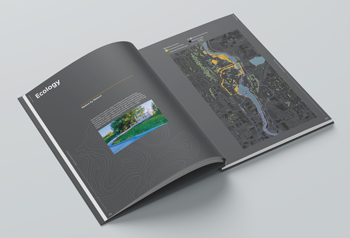
Imihy Bean stated that equity in their park system is a key driver in their master plan, and described Hopkins as a diverse community with about 38% of the population being non-white, and therefore the goal is for their parks to cater to a diverse set of interests. “Our engagement intentionally focused on engaging these populations to better understand where the gaps were in our system when it came to making our parks a safe and welcoming place for BIPOC folks in our community.”
Accessibility was also a big focus. “We’ll definitely be looking at ways we can expand accessibility in our playgrounds and facilities and ways we can be creative about including items that have a high degree of accessibility, like Bankshot courts.”
Master plans are also a great—and often essential—way to secure funding for various projects and allow for grant applications. “Finding funding sources for future park redevelopment is a core component of the plan,” said Imihy Bean. “The plan will help us prioritize how to spend our existing money on our parks, identify ways we can increase funding to the parks and evaluate our existing revenue streams. We do hope that a completed plan will make applying for state, federal and nonprofit lead grants possible.”
McDermott said that the success of securing funding and grants is highly dependent on how effectively the vision and plan are communicated, and if this is done up front, communities will have more success. “This communication should give a more elevated understanding of the design considerations and a comprehensive idea of what the design will look like when it’s complete. We also speak to the economies of the project, its contextual relationship to the community, the programming of the project and its overall economic impact.”
“Most grant agencies at least want to know that you have thought about this and built consensus so that the funding will be used without issues,” said Hornig. “Most states have Comprehensive Plan requirements or at least indicate preference for grant funding to those with current plans.” He added that typically these plans should be less than five years old.
In Indiana, communities are required to submit a five-year park and recreation master plan to the Indiana Department of Natural Resources (IDNR) to be eligible to apply for the Land and Water Conservation Fund (LWCF) grant program. Greg Beilfuss is chief planner at the IDNR Division of State Parks, Community Grants and Trails, which administers the program, and he said the LWCF program is very flexible in terms of the public outdoor recreation areas and amenities that can be developed. Some of the possible projects he mentioned include buying or developing new park land; building play areas and playgrounds; pools and splash pads; restrooms; shelters; sports fields and courts; picnic areas; trails (mostly within parks); and natural areas including wetlands, woods, prairies, riparian areas and more. “LWCF-funded grant projects are required by the grant to be protected and owned/operated as a public park by the local government deeded the property, in perpetuity.”
The IDNR website offers planning guidelines, downloadable documents, park plan examples and templates, and FAQs for park planners. Any local entities—county, township, city or town—that would like to submit a park and recreation master plan to IDNR simply for review, future LWCF grant potential, guidance or suggestions is welcome to do so; there is no requirement to apply for grants. Beilfuss said they receive 50-plus park master plans for review every year, though less than half will apply for a grant that same year; some just seek a professional outside review and commentary. “LWCF grant eligibility is one reason folks do plans, but the smart local governments plan to be data-driven, public input-based and proactive/cost-efficient.”
As far as public engagement, IDNR recommends a mixed-method public input methodology, according to Beilfuss. “Using different methods allows a planner to cross-compare each method’s results to ensure that they not only reach all their various publics, but also verify that the recorded input accurately reflects public needs.”
He said planning guidelines recommend at least one “random” public survey and at least two public meetings of some sort. If either or both of those methods yield low turnout—which he said is common when minimal advertising is done or no invitations to stakeholder groups are issued—then IDNR recommends using additional methods such as formal or informal focus groups, stakeholder meetings or other means. “The idea is for all communities creating a plan to make and carefully document a genuine good-faith effort to obtain wide-ranging, dependable, representative and accurate public input on which to base their plan’s decision-making paradigm.”
Beilfuss said that half to two-thirds of park plans they see each year are created totally in-house, by “ordinary citizens with no special training or knowledge of park planning.” He explained that the remaining consultant-based plans are completed by various consultants including nonprofits such as universities and colleges; for-profits including landscape architects and engineering firms; and even NGOs such as regional economic development agencies, regional planning agencies, etc. “Who completes the plan isn’t nearly as important as the time, data, analysis and brainstorming solutions that go into it. In this case, high price doesn’t predict or guarantee quality of a plan, careful thought does.”
Back in Hopkins, Imihy Bean said they reviewed many communities’ master plans before creating the Request for Proposal (RFP) for their project. “Specifically, we were interested in communities like Bloomington, Minn., and Duluth, Minn., where equity was a core component of the plan. We have a great partner in Minnetonka, Minn., who is our recreation provider and had recently updated their master plan and was a wonderful resource as we moved ahead with our planning efforts.”
Imihy Bean described Hopkins as a very unique urban community, with a population of about 19,000 in just four square miles. “We are very dense, with no greenfield development opportunities but a lot of redevelopment potential.” She explained that they’re the future home of three light-rail transit stations and with that comes new and exciting development, with about 1,000 new multi-family units being approved in 2022. “However, we really have no ability to acquire new parkland and that means we have to be really creative and intentional about our park spaces. Additionally, about 60% of our residents rent their homes, so community greenspace is a necessary amenity for our residents. We find ourselves at the intersection of a lot of change, and having a master plan is a really important tool in planning for the future of our community parks.”
Depending on the area and the community being served, park master plans take on a wide variety of focus areas and concerns, but the bottom line is to upkeep, improve and enhance spaces and programs for residents. “We’re really trying to create solutions that help a community become more holistic and allow them to offer amenities that benefit the health and well-being of users,” said McDermott, “and that also have the potential to create more tourism opportunities.” RM



